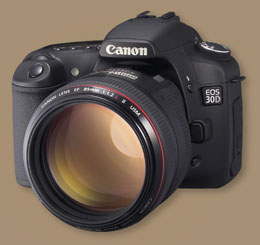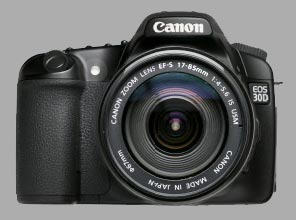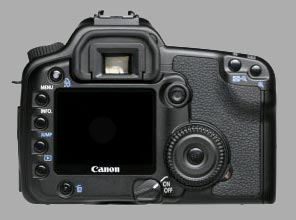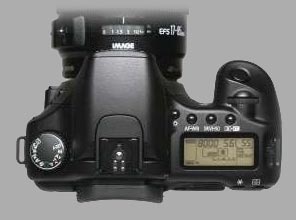 Updated 20D = 30D.
Updated 20D = 30D.
Hold the fan.
Save the fare.
Yes, it's a new model DSLR. No, it's not a MHD (Major Honkin' Deal).
What happens when you tweak the body, monitor, "Scene" modes, ISO increments, Shutter button, frame rate, and a few menu items on an already superb camera?
You get a superb camera.
Now what happens when you sell it for $100 US less?
You get a superb camera for $100 less.
For those expecting a revolution--a VGR (Very Good Reason) to sell off the old DSLR and jump into a brand new tuxedo full of features, flavors, f-stops, facets and fantastic fundamentals--right about now you're filled with awe. Except that you're saying it as "Aww..."
The 30D was NOT teased into a Big Introduction by Canon. They meant it as a nice, slight upgrade to the 20D, except for one thing.
The name.
It implies as much of an advance as the 20D is over the 10D, and that simply isn't the case.
 Had they done the Right Thing with the model name, it might have appeared as the 25D or 20D Mark II, and I'm sure there were people inside the Marketing Department that mulled that naming decision over for minutes.
Had they done the Right Thing with the model name, it might have appeared as the 25D or 20D Mark II, and I'm sure there were people inside the Marketing Department that mulled that naming decision over for minutes.
All the photographers I've talked to about it are in consensus: The Marketing Department meeting should have talked about the name for ten minutes.
Then word leaked out. Woo hoo! Something's coming from Canon. The world of Canon photographers, ever aware of the implications of the flashless 5D full-frame camera, pieced together a huge story of what the New Thing was doubtless going to be. Collectively they began writing a drama called
Imaginations Gone Wild!
The rumorists got it wrong on just about every particular. According to PMW (Popular Myth Wish) it would be a 10MP camera with six frames per second, HD movie mode and an internal image analysis engine that would reframe the picture before you took it, thus avoiding bad shots. OK, I made some of that up, but you get the gist.
 It has some really nice features. A 2.5-inch monitor with 230,000 pixels, much larger than the 1.8-inch screen of the 20D which had 180,000 image dots, makes it directly comparable with Nikon's upscaled D200 monitor.
It has some really nice features. A 2.5-inch monitor with 230,000 pixels, much larger than the 1.8-inch screen of the 20D which had 180,000 image dots, makes it directly comparable with Nikon's upscaled D200 monitor.
Canon has taken an idea similar to Scene modes into new territory with Portrait and Landscape modes augmented with what are best thought of as being different "film types." These apply to the P/S/A/M/A-Dep creative zone exposure modes.
There's Neutral, for later processing, Faithful for accuracy, Monochrome for instant dial-up B&W plus three User Defined settings that could be any combo of Chroma, Contrast, Sharpening, Tint, or in-camera color filtration you decide to memorialize.
 Added to the Meter options is a new 3.5% Spot Meter.
Added to the Meter options is a new 3.5% Spot Meter.
The shutter release uses a new switch hailed as the Soft Touch Electromagnetic Release™©®∞.
Things that haven't changed are image pixel count, basic operation (if you know the 20D, you know the 30D), 9-point AF, 35-zone metering, flash power, shutter sync speed, build quality, RAW options, ISO extremes, or top continuous fps rate. It does offer 1/3-stop increments for ISO and optional 3fps frame rate, though.
Like I said, a Great camera by any measure. Just not a Big Honkin' Next Camera.
Review. New feature: RGB histogram. Improvements in jumping to distant images, magnification improvements. Folders hold 9999 shots, up from the 20D's 100.
Plus: I could go on and on, but in order to do so, I'd have to witness more features to write about. In other words, that's it.
Bottom Line: If you were kinda thinking about a 20D, you can just stop that right this instant. Don't make me come back there. You need to start thinking about the 30D. You will like it and you will take terriffic pictures with it.
Editorial License:
Or, Let's get ready to grumble.
Although we have witnessed a conflagration of forum flames about this model--and none of them from people who have actually held one--the 30D may serve as the poster child of unintended Marketing Gaffes in Digital Photography. None of the fire and ire have anything at all to do with the machine itself--all of it is from blunted expectations.
When the name for a small, incremental update suggests a Major New Wonder, a clear but unintended mismatch is turned loose.
What's in a name? Enough so that phrase has been with us heavily since well before Shakespeare.
Names are IMPORTANT. They move our minds into specific directions and they raise our expectations. They are the core of our most fundamental expression system and form the heart of what we call intelligence. Canon has made a wonderful product, but their Department of Picking a Name blew it, big time.
Witness another company that had the same general idea but handled it right: Nikon's D70 felt the competitive pressure from the Canon 20D when the D70 was just a year old. Nikon increased the monitor dimensions, changed the color scheme in the menu system, added a few features and dropped the price a hundred dollars, quietly substituting the D70s into the line, replacing the D70.
At the same time, they released a firmware update for existing D70 cameras that elevated them to almost D70s tweaks. Customers were happy. Nobody got bent.
Canon's nomenclature suggests a new camera that is fully as big an improvement over the 20D as the 20D was over the 10D. I.e: Ten points.
Any rationale that was floated in the board room that disagreed with this perception falls into the category of "the irresistible pull of self-delusion," --a principle of decision making that has always been with us cheeky monkeys.
Canon would have been smart to have called the new camera the 25D, the 20Ds, 20Di or even the 20D Mark II, but to have squandered the "30D" name on this instrument was a capital crime, DSLR-marketing-wise.
The name sets the wrong ball rolling and Canon's Best Customers--all the folks who waited with baited breath for the NGT (Next Great Thing) are the ones doing the heavy grumbling.
When our most willing-to-buy target audience gets up and leaves, holding its collective nose, the problem is not in our stars, Horatio, it's in ourselves.
You can't buy publicity like that. But you can spend a fortune trying to move past it.
IMHO
Initial Recommendations: I'm going out on a limb, here, folks, but after having owned the 20D for nearly 18 months, I have to say that it's One Great Camera, thus making the 30D One Other Great Camera by inherited characteristics and obvious augmentations alone.
If you own a shelf of Canon lenses, here's your camera. If you own an EOS 350D or EOS 20D, there's not enough here to force you to sell the old one to get the 30D. But if you are looking for another Canon body, here it is.
If you are just now considering a DSLR for the first time, you owe your eyes a look at the Nikon D200, which, for more dollars, delivers many of the things Canon didn't include in the 30D. Bigger pixel map (not enough to generate a TLC [Truly Lustful Condition] but enough to count), more meter segments (1005) for a greater matrix of readings to feed the Auto Exposure computer, more fps options, more JPEG options, more Bracket options, more Flash options, more RAW options, more accurate battery condition display, more multi-exposure options, more time-lapse options, more control button options (31 vs 22 on the 30D)--all in a package that resists the occasional drizzle.
As experience grows with this most welcome camera, I'll revisit this report and update it. If you are looking for your first dSLR experience, this is a great starting place. It's not a camera for the total novice, but it has enough depth to take you from basic experience to pro results.
--Peter iNova (peter.inova@mac.com)
Up rezzed 10 16 06.